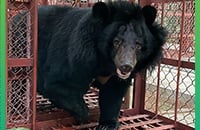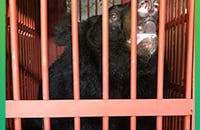From rescue to retirement: helping damaged bears grow old gracefully
17 February 2017
As rescued bears age they need more care than ever before – meet the hero who has dedicated 10 years to helping them do so with grace.
Having welcomed its first bears back in 2000, many of the 98 “residents” at Animals Asia’s Chengdu sanctuary are no longer young.
Bears can be expected to live to around 30 in the wild, but for bile farm survivors it is often much less.
Those who arrived as adults and have enjoyed more than 15 years with Animals Asia are now well into middle-age, while others are in their twilight years.
With the majority having arrived broken by lifetimes of cruel conditions and brutal bile extraction, these long-suffering bears require intensive care to manage their ailing bodies in old age.
As Animals Asia’s China Bear and Vet Team Director, Nic Field has dedicated the last 10 years of her life to giving hundreds of rescued bears exactly this.
She explains how sanctuary life has changed over the last decade as the bears have grown old, and the staff and centre have had to adapt to their changing needs.
Nic Field said:
“Over the last 10 years, we’ve had to be constantly ready to adapt to the bears’ needs. As time has gone on, increasing numbers of them suffer from failing joints, eyes and teeth – the usual ravages of old age.
“For our geriatric bears we have to constantly provide veterinary care and monitor their conditions as well as evolve our husbandry to maintain their welfare.
“It has an impact on resources as the entire make up of an enclosure often has to be tailored to the needs of the bears. Mobility issues associated with arthritisare a prime example.
“First we endeavour to minimise joint problems through weight monitoring and encouraging exercise. This is done by providing opportunities to forage, climb and do all things bears should do as well as providing them with a well-balanced diet.
“However, when bears arrive physically damaged – as so many do from bile farms – we have to take further steps. These bears require pain-killing and anti-inflammatory medications, regular check ups involving x-rays and physical exams, and constant observation to check for any changes to their mobility, behaviour and activity that could be indicative to progression of their condition.”
All the bears are monitored everyday for tell tale signs of illness, aging or problems they may be suffering. If it’s age, it may be time to adjust their environment and facilities.
Nic adds:
“When their mobility is compromised past a certain extent then – just as with older humans – we have to modify the environment to help them maintain independence. Some of our oldest bears are in specially designed areas with lower baskets and beds, ramps between den and enclosure, non-slip flooring and smaller scale living areas.
“The boisterous life of bear communities also means that the weakest bears are housed together in a separate enclosure we call a ‘special care area’. It is essentially a retirement home where they have one or two companions of a similar age and don’t have to compete for food or fend off younger would-be playmates.
“When dealing with bears at the end of their lives, quality of life is a constant question for us. We work closely as a team – veterinary staff, bear management and bear care staff – to assess all aspects of an individual’s quality of life. We have to take into account, not just what is normal for the species, but normal for this individual. Reviewing records, visual observations and assessing whether we can control their pain and provide them with all they need and deserve. These animals have been rescued from pain and suffering, we have no intention of making them needlessly suffer more.”
The team experiences a rollercoaster of emotion. From welcoming the bears to the sanctuary, right through to what can be a devastating goodbye.
Nic concludes:
“This job really does encapsulate the full range of emotions. I have seen bears rescued and rehabilitated into loving bear communities. I have seen bears develop friendships – and sometimes even enemies – as they are all individuals and not everyone gets along.
“There is no better job satisfaction than to see a long-suffering bear finally enjoy their life in the sunshine. But there are only so many sunny days for each bear. As my time has gone on here I have had to say goodbye to bears who I have truly loved, but I do so knowing that the whole team have done everything they possibly can to give them the quality of life they deserve for as long as possible.”
Animals Asia’s China Bear Rescue Centre currently has seven bears in their Special Care area. Of the centre’s 98 bears, over 20 are considered to be elderly although defining old age is difficult as the exact age of the bears is not known.
BACK









 Freedom after two decades: Moon bears Nang and Mua rescued
Freedom after two decades: Moon bears Nang and Mua rescued
 With heavy hearts we say goodbye to our beloved Tulip
With heavy hearts we say goodbye to our beloved Tulip
 Three moon bears rescued from notorious bear bile farming hotspots in Vietnam
Three moon bears rescued from notorious bear bile farming hotspots in Vietnam